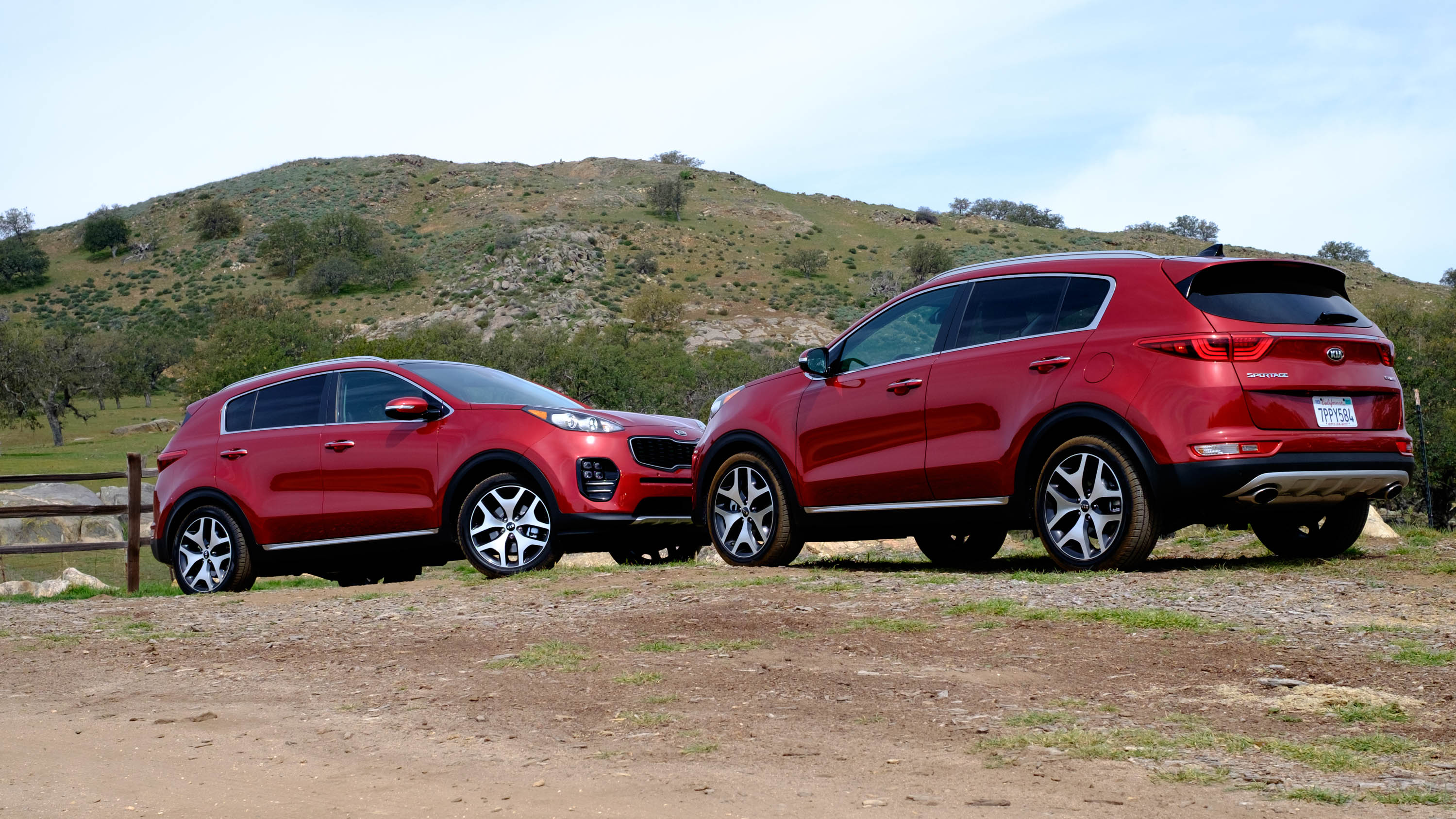TechRadar Verdict
Kia strikes the right balance for technology, comfort, performance and amenities to create a segment leader
Pros
- +
Android Auto support
- +
Harman Kardon Clari-Fi technology
- +
Hands-free smart trunk
Cons
- -
No adaptive cruise control
- -
Apple CarPlay not supported yet
Why you can trust TechRadar
As a 90s kid, I watched Kia grow up and have worse commitment problems than a teenager, at least when it came to model names (anyone remember the Sephia, Spectra or Amanti?). The heart of Kia is the Sportage, which has been around since Haddaway asked us "What is Love?," and the perfect embodiment of how far it has come.
When the Sportage first launched, it was a traditional sport utility vehicle that shared a platform with a Mazda van and didn't stand out from Japanese competitors. Even the 2.0-liter four-cylinder engine the Sportage used was a Mazda design. Kia was the last amigo standing, because Isuzu and Suzuki are shells of its former self.
The latest (fourth generation) Kia Sportage made its North American debut at the 2015 LA Auto Show, with a fresh face that reminds me of a Porsche Macan – certainly not a comparison I ever expected to make in my lifetime, and at half the price, no less.
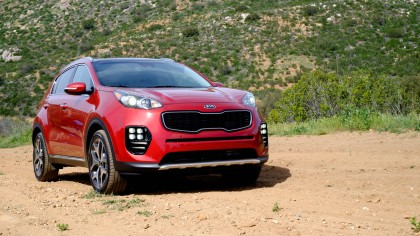
I flew out to San Diego, Calif. to sample a pair of top-end Kia Sportage SX Turbo, in front-wheel drive (FWD) and all-wheel drive (AWD) configurations. Pricing for the Sportage SX Turbo starts at $33,395 (£24,350 for the similar GT-Line and AU$47,992 for the Platinum trim) for the FWD model, while AWD is an extra $1,500.
On the outside, the Sportage sports a smiley face that's grown on me since its LA Auto Show debut. It's an aggressively happy-looking car, like the grin of an evil genius, but incorporates Kia's trademark tiger nose grille and ice cube LED driving lights.
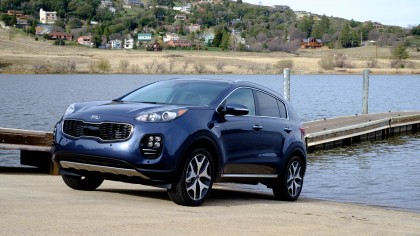
Kia treats the AWD models to a unique front fascia that provides a greater approach angle of 28 degrees, compared to the 16.7 on FWD configurations, for the illusion of off-road capability. AWD models have an extra 0.4-inch of ground clearance, but the breakover and departure angles only differ by less than a degree.
Around back is the sexiest stance on the Sportage, with full LED tail lights and rear skid plate, finished with dual exhaust tips. I find the new design striking, but the best part is Kia's minimalist approach to chrome use.
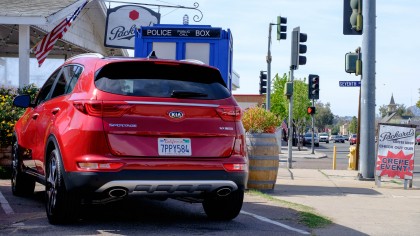
There's a little chrome detail in the headlights and the strip at the center of the tail lights, but the rest of the car's brightwork is satin silver. Chrome on modern cars isn't my forte and I always thought it was a cheesy way to dress up a car.
Interior
Step inside and you'll find a driver-focused interior with high-quality materials. The entire top half of the dash consists of a single form-fitted soft-touch piece, which is unusual in this segment. Its competitors typically have a piece of hard plastic to transition to the windshield, but Kia extends the soft-touch material all the way.
Everything below the infotainment display is hard plastic, but the texture and feel disguises it nicely. The armrests are wrapped in vinyl with padding that makes it comfortable to rest one's elbows on.
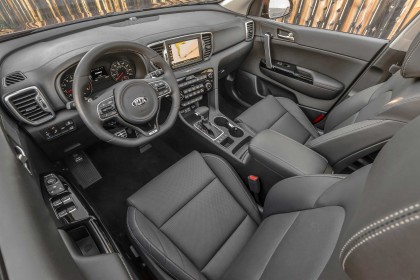
Kia sticks to good ole-fashioned physical buttons that click, which I prefer because each click corresponds to a command. There's no second-guessing if you pressed the button correctly or not, like with capacitive touch buttons. The one thing I don't like is the use of gloss black trim in the most frequently touched locations – smudges galore, you know?
Kia did a great job with the interior of the Sportage. Before flying to San Diego for the Sportage drive, I was testing a RAV4 Hybrid Limited (review coming soon), and the Sportage interior is leagues ahead of Toyota and could almost pass as a Lexus.
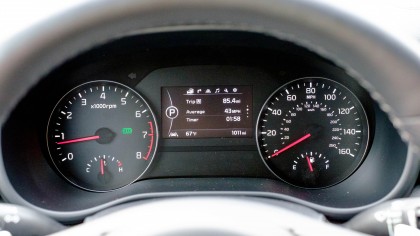
Grab the steering wheel and you'll feel like Speed Racer thanks to a sporty flat-bottom wheel with thumb grips wrapped in leather. Look ahead and you'll find analog gauges for the tachometer, coolant temperature sensor, speedometer and fuel level.
A 4.2-inch LCD display is sandwiched between the gauges and provides turn-by-turn navigation, trip information, driver assistance information, music information and access to vehicle settings. As much as I love technology, I still prefer analog gauges for traditional functions, because it's simple and works without any visual lag like budget LCD cluster implementations.
Infotainment system
The infotainment system in the Kia Sportage is quite familiar and essentially the same system as the Hyundai Tucson, with a user interface that is identical to the Kia Optima,too. Kia uses the same 8-inch 800 x 480 resolution screen as the Tucson, but tilts it towards the driver.
There is one major difference, however. The Kia Sportage supports Android Auto from the get-go while the Tucson is still TBD. Onboard navigation is included with plain flat maps; in case you don't want to rely on your phone.
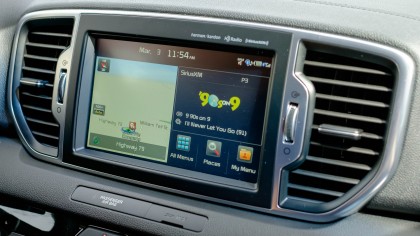
The one thing I love about Kia's navigation function is the ability to enter addresses and search for points of interest when the car is moving, so my passenger can use it. The car does display a liability warning each time you start the car, but you're free to do as you wish when the car moves.
I like the Kia infotainment interface a lot -- it's simple and easy to use with a mix of on screen and physical buttons. My primary annoyance is the lack of a physical home button that takes the system to its split-home screen. There's an onscreen button in the top left corner, but tapping items near the edge of a recessed touchscreen is pretty much the worst.
Music playback is available via USB, Bluetooth, HD Radio and SiriusXM. A single USB port is located in a cubby above the shifter, with plenty of space for large phablets like my Nexus 6. SiriusXM playback supports time-shifting on the first six presets so you can put Adele's Hello on repeat to your heart's content.
In case you only needed a USB port to charge your phone, Kia installs a USB charging port inside the center console. Rear passengers have a USB charging port of their own, too.
Android Auto & Apple CarPlay
Kia supports Android Auto and Apple CarPlay in the Sportage, but only Android Auto is ready at launch. Apple CarPlay support is promised in April via a software update, but we're still waiting for Kia to deliver on its promise with the Optima as well, so it might be a long wait.
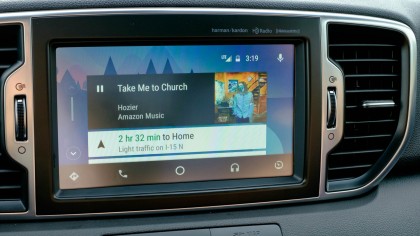
Nevertheless, Android Auto works great in the Sportage. I tested it with my Nexus 6 and my driving partner's Samsung Galaxy S6 Edge Plus. The Nexus 6 worked perfectly upon first plug-in, but the S6 Edge Plus required some finagling within settings to get the Android Auto prompts to show up on the phone.
Android Auto in the Sportage is very good: it lets you use simultaneously use your phone and native infotainment features. You can listen to music via Android Auto while using the onboard navigation or listen to SiriusXM while using Google Maps. The interoperability is seamless.
